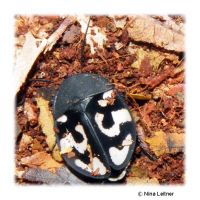Questionmark Roach (Therea olegranjeani)
| Questionmark Roach Therea olegranjeani | |
|---|---|
| Name | Questionmark Roach |
| Name Lat. | Therea olegranjeani |
| Family | Sand Cockroaches |
| Family lat. | Corydiidae |
| Order | Cockroaches |
| Order lat. | Blattodea |
| Origin | India |
| Habitat | Forest |
| Diet | Dead wood, leaves, veggies, fruits |
| Humidity | 40-70 % |
| Behavior | Peaceful |
| Keeping | Group |
| Care Level | Easy |
| Housing | Dry terrarium |
| Breeding | Moderately difficult |
| Life Span | 6-12 months |
| Protection | No |
| Metric Units | |
| Size | 18-25 mm |
| Temperature Day | 25-30 °C |
| Temperature Night | 20-25 °C |
| Housing Size | 40 x 30 x 30 cm |
| US Units | |
| Size | 0.7"-1" |
| Temperature Day | 77-86 °F |
| Temperature Night | 68-77 °F |
| Housing Size | 15" x 10" x 10" |
Distribution and habitat
The question mark cockroaches originate from the state of Andhra Pradesh in southeastern India. These attractive cockroaches live in larger groups, often staying on the surface among foliage, branches and dead wood during the day and usually only seeking shelter in the soil at night.
Maintenance
A terrarium of 40 x 30 x 30 cm (L x W x H) is recommended for a group of up to 30 animals. A hinged-lid terrarium or an aquarium with a tight-fitting lid made of fine gauze is best, because the adult animals can run up the panes and escape. The terrarium should be placed in a quiet place without direct sunlight.
The at least 10 cm deep substrate of loose, slightly moist sand-soil mixture or terrarium humus should be covered with a dry layer of foliage (e.g. oak leaves). On top of this, pieces of cork or bark as well as some cork tubes provide shelter and hiding places. Climbing branches and a small, shallow water bowl complete the setup. Waterlogging and mold must be avoided at all costs
| Temp. day: 25-30 °C | Temp. night: 20-25 °C | Humidity: 40-70 |
The lighting duration should be 8-10 hrs. Daylight fluorescent tubes supplemented with spotlights that generate the necessary heat are ideal.
Diet
Question mark cockroaches are omnivores. The main diet consists of dead wood and foliage, in addition, a combination of vegetables, fruit and some animal protein is ideal. Carrots, lettuce, zucchini, apples and oatmeal mixed with dry dog or cat food as well as dry fish food are particularly suitable as supplementary food. Special care should be taken to feed only unsprayed and well washed fruits and vegetables. Water or water gel should always be available in a small, shallow bowl.
A varied diet promotes health and prevents deficiency symptoms.
Reproduction and breeding
Males are slightly smaller than females and have longer wings
The more massive females form a 1 cm long ootheca (egg capsule) after fertilization, which is deposited in the substrate. After about 2-4 months, the fully developed nymphs, about 3 mm in size, hatch. Depending on temperature and nutrition they are fully grown and sexually mature after another 10-12 months (imaginal moult). After that they have a life expectancy of 6-12 months.
Important
Before buying should be prepared terrarium that meets the specific needs of the species. Necessary are good ventilation without drafts and devices for measuring temperature and humidity. The lighting has to correspond to the species-specific day-night rhythm and has to be installed in such a way that the animals cannot injure themselves
The terrarium should be locked in such a way that neither unauthorized persons can open it nor the animals can escape. Special attention must be paid to thorough hygiene and impurities must be removed regularly.
Further literature can be found in your pet store.
References
Text: Nina Leitner; Image: Nina Leitner
Source: HENKEL & SCHMIDT (2010): Taschenatlas Wirbellose für das Terrarium, Ulmer Verlag; ENGELMAN & LANGE (2011): Zootierhaltung - Tiere in menschlicher Obhut: Wirbellose, Verlag Harri Deutsch
